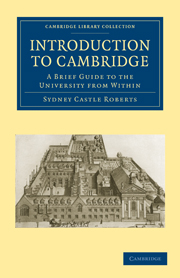IV - UNDERGRADUATE
Published online by Cambridge University Press: 10 November 2010
Summary
Of the greater part of what has been briefly described in the preceding chapter the undergraduate is happily ignorant. The senior members of the university are to him just “dons”, and while from the first he recognises some as responsible for his instruction and discipline, and later reckons some of them among his personal friends, he is not called upon to examine the machinery of government either in his college or in the university.
To become a member of the university, he must first choose his college. A variety of considerations may govern his choice. He may, in the first instance, choose a college because his family or his school or his friends have associations with it. If he has no a priori preference of this kind, he will enquire as to the characteristics of individual colleges: he may be attracted by the reputation of a particular tutor or teacher in one college or by the athletic distinction of another. Again, he may base his choice on a preference for a large college to a small college, or vice versa. In modern Cambridge, however, the small college containing 50 or 60 undergraduates has ceased to exist. The smallest colleges (Peterhouse, Corpus Christi and Selwyn) have about 160 undergraduates each; five colleges (King's, Trinity Hall, Magdalene, Sidney Sussex, Downing) have between 180 and 260 each; another eight (Clare, Pembroke, Queens’, Christ's, Jesus, Emmanuel, Gonville and Caius, St Catharine's) have between 280 and 330 each; St John's has 430, and Trinity 670; there are also about 200 non-collegiate undergraduates, the majority of whom are members of Fitzwilliam House.
- Type
- Chapter
- Information
- Introduction to CambridgeA Brief Guide to the University from Within, pp. 71 - 91Publisher: Cambridge University PressPrint publication year: 2009First published in: 1934



